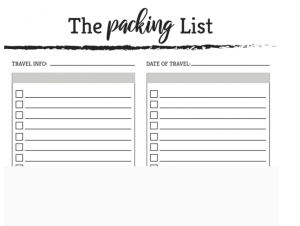Everything You Should Know About Packing List
Exporters, international freight forwarders, and the ultimate consignee all need access to the same information about sent items, and this is where the packing list comes in. Information on the items’ packaging, including any special marks or numbers that appear on the box’s outside, is also included on the list. Packaging lists go by many other names, including delivery notes, manifests, transportation notes, customer receipts, and unpacking checklists.
Briefly describe a packing list.

What Is Packing List?
A packing list is a document that is often included in the packaging and has a comprehensive inventory of the contents. Warehouse workers and clients can consult the packing list on hand to see what items should be placed inside each box.
The packing list is generally only a piece of paper with the order’s details printed on it, and it is shipped alongside the goods. The packing list may or may not include specifics about each order, depending on the nature of the shipment.
Most online business cannot function without these remarks. Almost every part of transit relies on the packing list:
During product choosing, the transportation department prints the packing list to double check that all of the right things are being placed in the box. Utilizing packing lists to sort the chosen products into the appropriate boxes for order fulfillment, barcode picking and packaging procedures are among the most efficient order picking methods in warehouses.
The receiving section utilizes the packing list to double-check the orders they’ve received. If there are any inconsistencies between the box’s contents and the packing list, the product will be held up until the problems are resolved.
Owner of a Company: The packing list will help the company remember what’s inside the box and how much to charge for shipment based on its contents.
Personnel in Charge of Transport: In order to protect the contents of each box during shipping, the packing list provides essential instructions for doing so.
After receiving their delivery, consumers can double-check their order by referring to the packing slip.
What items go on the list of things to pack?
Information useful for proper order packaging is included on the packing list. Although each company’s and item’s packing list will have somewhat different information, it will often include the following:
1. Details about the Purchaser and the Order
The packing slip provides extensive client and order details, such as:
Name of purchaser and shipping address
Purchased On:
A purchaser’s contact details
2. Contents list of the box
The packing slip details everything that was purchased from the order down to the last detail, including the product’s exact color and design. Separately transported products may also be listed on the packing list.
3. The Amount of a Product
Multiple items of the same category can be purchased by a single customer. The packing list can be kept to a manageable length by adding the amount next to each item. When packing orders for shipment, workers at the warehouse count the quantity of each product category.
4.Weight of the Item
The dimensions and total weight of the item within the box are detailed on the packing list. The right shipping cost may be calculated if a company knows how much an item weighs.
To keep track of their stock, businesses like Origin or UPC employ the product-specific identification codes. A Quick Response (QR) code, Universal Product Code (UPC), or Stock Keeping Unit (SKU) number might serve this purpose. Barcode labels printed with simple label software are widely used by e-commerce businesses.
Is the shipping label also the packing list?
Packing lists and shipping labels serve various functions and are often confused by warehouse staff. Some key distinctions between the two sorts of paperwork are as follows:
The label’s intended function is to both inform consumers about what they’re receiving and direct warehouse workers to the relevant products in the order. Carriers use transportation labels primarily for the purposes of tracking and transporting items. Business organizations still rely on shipping labels for inventory management.
Shipping labels are usually affixed to the outside of goods so that carriers can easily see and scan them. However, the packing list is included in the package itself.
Buyer and company details, together with package weight and dimensions, are recorded on both forms of paperwork. However, the shipping label just shows the date shipped, the shipping priority, and any special delivery instructions, rather than any specifics about the things being shipped.
What distinguishes an invoice from a packing list?
Workers may also get invoices, which serve a different purpose and include different information than packing lists, mixed up with them. Invoices are legal tools used to make sure that clients pay what they owe by the due date. Some key distinctions between packing slips and invoices are as follows:
The invoice is intended for the order’s buyer, whereas the packing list is intended for warehouse workers and the receivers of the packages they receive. The buyer and the recipient are not necessarily the same person.
Invoices often provide more specifics, such as product prices, payment terms, and purchase dates, than do packing slips.
At this point in time in the ordering process, when a consumer makes a purchase on the e-commerce platform, an invoice is generated. When a warehouse uses its order fulfillment system to begin the packaging process, a packing list is generated.


Top 10 Creative Cosmetic Packaging Design Ideas & illustrations 2023 | Luxury-Paper-Box.Com

10 Customs Of The Spring Festival (Lunar New Year) You Need To Know

Top 10 Best Lattafa Perfumes for Women & Men in 2024

Top 10 Best Packaging Design Software 2023 (Free & Paid)

Why Choose MDF Boxes Over Wooden Boxes?



 kali@luxury-paper-box.com
kali@luxury-paper-box.com




